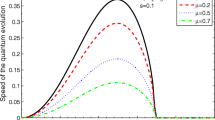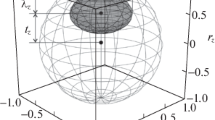Abstract
Quantum speed limit time defines the limit on the minimum time required for a quantum system to evolve between two states. Investigation of bounds on speed limit time of quantum system under non-unitary evolution is of fundamental interest, as it reveals interesting connections to quantum (non-)Markovianity. Here, we discuss the characteristics of quantum speed limit time as a function of quantum memory, quantified as the deviation from temporal self-similarity of quantum dynamical maps for CP-divisible as well as indivisible maps, and show that the presence of quantum memory can speed up quantum evolution. This demonstrates the enhancement of the speed of quantum evolution in the presence of quantum memory for a wider class of channels than indicated by the CP-indivisibility criterion.




Similar content being viewed by others
Data availability
All data generated or analysed during this study are included in this published article.
References
Breuer, H.-P., Petruccione, F., et al.: The Theory of Open Quantum Systems. Oxford University Press, Oxford (2002)
Banerjee, S.: Open Quantum Systems: Dynamics of Nonclassical Evolution. Springer, Berrlin (2018)
Kumar, N.P., Banerjee, S., Chandrashekar, C.: Enhanced non-Markovian behavior in quantum walks with Markovian disorder. Sci. Rep. 8(1), 1–7 (2018)
Thomas, G., Siddharth, N., Banerjee, S., Ghosh, S.: Thermodynamics of non-Markovian reservoirs and heat engines. Phys. Rev. E 97(6), 062108 (2018)
Shrikant, U., Srikanth, R., Banerjee, S.: Non-Markovian dephasing and depolarizing channels. Phys. Rev. A 98(3), 032328 (2018)
Kumar, N.P., Banerjee, S., Srikanth, R., Jagadish, V., Petruccione, F.: Non-Markovian evolution: a quantum walk perspective. Open Syst. Inf. Dyn. 25(03), 1850014 (2018)
Bhattacharya, S., Banerjee, S., Pati, A.K.: Evolution of coherence and non-classicality under global environmental interaction. Quantum Inf. Process. 17(9), 1–30 (2018)
Naikoo, J., Dutta, S., Banerjee, S.: Facets of quantum information under non-Markovian evolution. Phys. Rev. A 99(4), 042128 (2019)
Utagi, S., Srikanth, R., Banerjee, S.: Ping-pong quantum key distribution with trusted noise: non-Markovian advantage. Quantum Inf. Process. 19(10), 1 (2020)
Naikoo, J., Banerjee, S., Chandrashekar, C.: Non-Markovian channel from the reduced dynamics of a coin in a quantum walk. Phys. Rev. A 102(6), 062209 (2020)
Rivas, A., Huelga, S.F., Plenio, M.B.: Quantum non-Markovianity: characterization, quantification and detection. Rep. Prog. Phys. 77(9), 094001 (2014)
Breuer, H.-P., Laine, E.-M., Piilo, J., Vacchini, B.: Colloquium: Non-Markovian dynamics in open quantum systems. Rev. Mod. Phys. 88(2), 021002 (2016)
de Vicente, J., Spee, C., Sauerwein, D., Kraus, B.: Entanglement manipulation of multipartite pure states with finite rounds of classical communication. Phys. Rev. A 95(1), 012323 (2017)
Li, L., Hall, M.J., Wiseman, H.M.: Concepts of quantum non-Markovianity: a hierarchy. Phys. Rep. 759, 1–51 (2018)
Deffner, S., Lutz, E.: Quantum speed limit for non-Markovian dynamics. Phys. Rev. Lett. 111(1), 010402 (2013)
Liu, H.-B., Yang, W., An, J.-H., Xu, Z.-Y.: Mechanism for quantum speedup in open quantum systems. Phys. Rev. A 93(2), 020105 (2016)
Cimmarusti, A., Yan, Z., Patterson, B., Corcos, L., Orozco, L., Deffner, S.: Environment-assisted speed-up of the field evolution in cavity quantum electrodynamics. Phys. Rev. Lett. 114(23), 233602 (2015)
Mandelstam, L., Tamm, I.: The uncertainty relation between energy and time in non-relativistic quantum mechanics. J. Phys. 9, 249–254 (1945)
Margolus, N., Levitin, L.B.: The maximum speed of dynamical evolution. Phys. D 120(1–2), 188 (1998)
Levitin, L.B., Toffoli, T.: Fundamental limit on the rate of quantum dynamics: the unified bound is tight. Phys. Rev. Lett. 103(16), 160502 (2009)
Deffner, S., Campbell, S.: Quantum speed limits: from Heisenberg’s uncertainty principle to optimal quantum control. J. Phys. A: Math. Theor. 50(45), 453001 (2017)
Giovannetti, V., Lloyd, S., Maccone, L.: Quantum limits to dynamical evolution. Phys. Rev. A 67(5), 052109 (2003)
Uhlmann, A.: An energy dispersion estimate. Phys. Lett. A 161(4), 329 (1992)
Deffner, S., Lutz, E.: Energy-time uncertainty relation for driven quantum systems. J. Phys. A: Math. Theor. 46(33), 335302 (2013)
Taddei, M.M., Escher, B.M., Davidovich, L., de Matos Filho, R.L.: Quantum speed limit for physical processes. Phys. Rev. Lett. 110(5), 050402 (2013)
del Campo, A., Egusquiza, I.L., Plenio, M.B., Huelga, S.F.: Quantum speed limits in open system dynamics. Phys. Rev. Lett. 110(5), 050403 (2013)
Wu, S.-X., Yu, C.-S.: Quantum speed limit for a mixed initial state. Phys. Rev. A 98(4), 042132 (2018)
Wu, S.-X., Yu, C.-S.: Quantum speed limit based on the bound of Bures angle. Sci. Rep. 10(1), 5500 (2020)
Paulson, K.G., Satyanarayana, S.V.M.: Relevance of rank for a mixed state quantum teleportation resource. Quant. Inf. Compt. 14(13 &14), 1227–1237 (2014)
Paulson, K.G., Satyanarayana, S.V.M.: Bounds on mixedness and entanglement of quantum teleportation resources. Phys. Lett. A 381(13), 1134 (2017)
Teittinen, J., Lyyra, H., Maniscalco, S.: There is no general connection between the quantum speed limit and non-Markovianity. New J. Phys. 21(12), 123041 (2019)
Paulson, K.G., Panwar, E., Banerjee, S., Srikanth, R.: Hierarchy of quantum correlations under non-Markovian dynamics. Quantum Inf. Process. 20(4), 1–26 (2021)
Utagi, S., Srikanth, R., Banerjee, S.: Temporal self-similarity of quantum dynamical maps as a concept of memorylessness. Sci. Rep. 10, 15049 (2020)
Banerjee, S., Ghosh, R.: Dynamics of decoherence without dissipation in a squeezed thermal bath. J. Phys. A: Math. Theor. 40(45), 13735 (2007)
Ghosal, A., Das, D., Banerjee, S.: Characterizing qubit channels in the context of quantum teleportation. Phys. Rev. A 103(5), 052422 (2021)
Funo, K., Shiraishi, N., Saito, K.: Speed limit for open quantum systems. New J. Phys. 21(1), 013006 (2019)
Das, A., Bera, A., Chakraborty, S., Chruściński, D.: Thermodynamic quantities in quantum speed limit for non-Markovian dynamics, arXiv preprint arXiv:2105.15083 (2021)
Yu, T., Eberly, J.: Entanglement evolution in a non-Markovian environment. Opti. Commun. 283(5), 676–680 (2010)
Kumar, N.P., Banerjee, S., Srikanth, R., Jagadish, V., Petruccione, F.: Non-Markovian evolution: a quantum walk perspective. Open Syst. Inf. Dyn. 25(03), 1850014 (2018)
Mazzola, L., Piilo, J., Maniscalco, S.: Frozen discord in non-Markovian dephasing channels. Int. J. Quantum Inf. 9(03), 981–991 (2011)
Miszczak, J.A., Puchała, Z., Horodecki, P., Uhlmann, A., Życzkowski, K.: Sub-and super-fidelity as bounds for quantum fidelity. Quant. Inf. Compt. 9, 0103–0130 (2009)
Campaioli, F., Pollock, F.A., Binder, F.C., Modi, K.: Tightening quantum speed limits for almost all states. Phys. Rev. Lett. 120(6), 060409 (2018)
Paulson, K.G., Banerjee, S.: Quantum speed limit time: role of coherence as a dynamical witness to distinguish multi-qubit entangled states, arXiv preprint arXiv:2202.08078 (2022)
Acknowledgements
SB and RS acknowledge the support from the Interdisciplinary Cyber-Physical Systems (ICPS) programme of the Department of Science and Technology (DST), India, Grant No.: DST/ICPS/QuST/Theme-1/2019/6 and DST/ICPS/QuST/Theme-1/2019/14, respectively. RS also acknowledges the support of DST, India, Grant No. MTR/2019/001516.
Author information
Authors and Affiliations
Corresponding author
Additional information
Publisher's Note
Springer Nature remains neutral with regard to jurisdictional claims in published maps and institutional affiliations.
Appendix
Appendix
An MT type bound, in which speed limit is derived in terms of variance of the generator, was obtained as a function of quantum Fisher information for non-unitary evolution [25]. A bound on \({\mathcal {B}}(\rho _{0},\rho _{\tau })\) can be obtained in terms of the integral of the quantum Fisher information \(F_{Q}(t)\) along the evolution path. The Bures fidelity \({\mathcal {F}}\) (Eq. 16) is connected to the quantum Fisher information \(F_{Q}(t)\) [25],
Quantum Fisher information is defined by \(F_{Q}(t)=\text {tr}[\rho (t)L^2(t)]\). Here, the Hermitian operator \({\hat{L}}(t)\) is known as the symmetric logarithimic derivative (SLD) operator. It is defined as \(d{\hat{\rho }}(t)/dt=({\hat{\rho }}(t){\hat{L}}(t)+{\hat{L}}(t)\hat{\rho (t)})/2\).
Quantum speed limit \(V_{QSL}\) is plotted as a function of the measure of non-Markovianity \(\zeta \) for OUN, RTN and NMAD channels. Quantum speed limit \(V_{QSL}\) is estimated for the initial states \(\frac{1}{\sqrt{2}}[\vert 0\rangle +\vert 1\rangle ]\) for OUN and RTN channels, and \(\vert 1\rangle \langle 1\vert \) for NMAD.The channel parameter \(\Gamma =0.1\mu \), \(\Gamma =\frac{1}{4}\mu \) and \(\frac{a}{\mu }=1\) for NMAD, OUN and RTN, respectively, for an actual driving time \(\tau =1\)
The instantaneous speed of evolution between two time intervals is proportional to the square root of quantum Fisher information. The upper bound on Bures angle is,
and the quantum speed limit can be identified as,
This bound is attained only if the evolution occurs on a geodesic, a condition for the MT bound for unitary evolution under a time-independent Hamiltonian.
We estimate the quantum speed limit \(V_{QSL}\) in terms of quantum Fisher information for CP-divisible and CP-indivisible maps, for various initial pure states; \(\frac{1}{\sqrt{2}}(\vert 0\rangle +\vert 1\rangle )\) for OUN and RTN channels, and \(\vert 1\rangle \langle 1\vert \) for the non-Markovian amplitude damping channel. In Fig. 5, the quantum speed limit is seen to increase as non-Markovianity increases for both CP-divisible and indivisible channels. Thus, the evolution speed of quantum states is seen to increase with the strength of non-Markovianity.
Rights and permissions
Springer Nature or its licensor holds exclusive rights to this article under a publishing agreement with the author(s) or other rightsholder(s); author self-archiving of the accepted manuscript version of this article is solely governed by the terms of such publishing agreement and applicable law.
About this article
Cite this article
Paulson, K.G., Banerjee, S. & Srikanth, R. The effect of quantum memory on quantum speed limit time for CP-(in)divisible channels. Quantum Inf Process 21, 335 (2022). https://doi.org/10.1007/s11128-022-03675-7
Received:
Accepted:
Published:
DOI: https://doi.org/10.1007/s11128-022-03675-7





